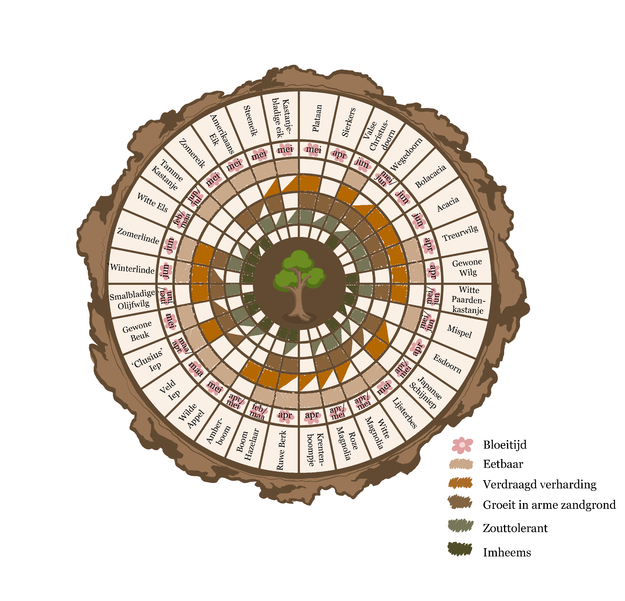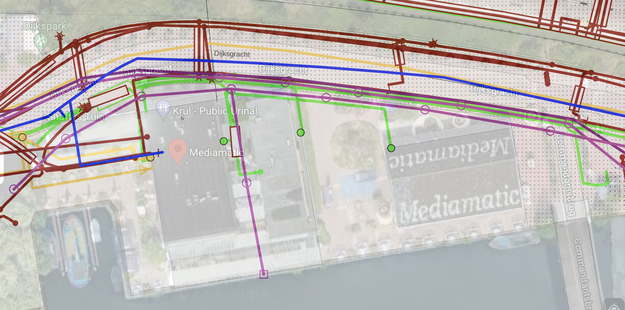Finding suitable tree species
In order to choose the right trees for our soil conditions and requirements, a research was done by Britt Vendel. The soil on the Mediamatic terrain is mostly sand and poor in nutrients, which means we should look for trees that tolerate those conditions. Max Ciaglo, a former Korreltje Zout Research Assistant at Mediamatic also concluded that our soil has a salt concentration in a range which goes from 2 dS-1 to 5 dSm-1. This is due to the combination of salt water coming from the Noordzeekanaal and the fresh surface water. Therefore the concentration of salt in the groundwater isn’t as high as seawater, but is still at a level in which trees need to have a tolerance to it. Our location also brings the requirement for the trees to tolerate pavement conditions. And lastly we wanted the trees to be native or at least have a history in The Netherlands since the 17th century.
In the information graphic below you can see the different tree species and whether they meet our requirements.
After reviewing many studies on different tree species, a selection of three species was made. We decided to plant one Chestnut, one Linden and two Elm trees. We then researched the medicinal properties of these tree species, so they could also be part of our ijKruid project. These are the 3 chosen species and their uses.
1. White Horse Chestnut (Aesculus Hippocastanum)
Although this species of Chestnut is not edible, historically this tree was used for many conditions, like joint pain, bladder, male infertility, fever, leg cramps, and more. Today, the extract from the chestnut seeds is used as the treatment for chronic venous insufficiency, because of its aescin content. The chestnut also has anti-inflammatory and anti-oedematous properties and indicates a positive effect on the venous tone and blood circulation. Chestnuts are also a great ingredient for soap making, because of its high levels of saponins, which are natural compounds with detergent-like properties.
2. Linden (Tilia Platyphyllos)
Linden flowers have been suggested to treat fever, colds, cough, infections, inflammation, high blood pressure and headache. Its wood is used for liver and gallbladder disorders and skin inflammation. Linden is also part of a group of ‘nerve tonic’ herbs that are used for anxiety.
Parts of the tree are edible. The dried flowers are mildly sweet and sticky and the fruit can also be a bit sweet. From the Linden flowers you can make delicious tea, syrup and liquor, because of the aromatic volatile oil that's found in the flowers. The leaves are also edible and contain vitamins B, C and E, but also contain minerals such as Calcium and Magnesium. Before the tree starts flowering, the leaves taste wonderfully tender in a raw salad. Later in the season you can cook the tougher leaves like spinach.
3. Elm (Ulmus Clusius)
Ulmus is known for its medicinal properties. It can treat digestive problems, reduce inflammation, and improve circulation. It is also believed to have antioxidant and anti-cancer properties and it may help to reduce cholesterol levels.
Parts of the tree are edible. The leaves can be eaten raw or cooked. The young leaves are not as bitter as full-grown ones. The immature fruits can be used just after they have formed. They have an aromatic and fresh flavor and they contain about 34,4 % protein. A tea can be made from the leaves.
Choosing tree locations
To choose the locations for the trees we needed to investigate the location of pipes and cables under the pavement. By reviewing a KLIC map of the City of Amsterdam, we found the locations on the property that were free of cables and thereby a safe location for planting a tree. This was a very limited area. We chose the exact locations by integrating other important aspects like walkability, availability for parking and having enough space to build a pigeon tower around some of the trees.
Planting the trees
Then we could finally start planting the trees. We wanted to give the trees a nice start to their new life at Mediamatic, by planting them with compost. Since this experiment is about building new pigeon towers around the stem of some of these trees, we finally had a new purpose for the mycelium-pigeon-towers that had become compost. These old towers could now become part of the new ones. With this, the circle of nutrients was completed.The shrinkage and decay of previous towers became part of growth and progress for new ones, an integral part of the design process.
Arne and Britt are planting the Linden tree with compost, photo by Romy Kerkman - Arne, Britt and Emma are planting the Linden tree, photo by Romy Kerkman - Britt is unloading a tree with the delivery man, photo by Romy Kerkman - 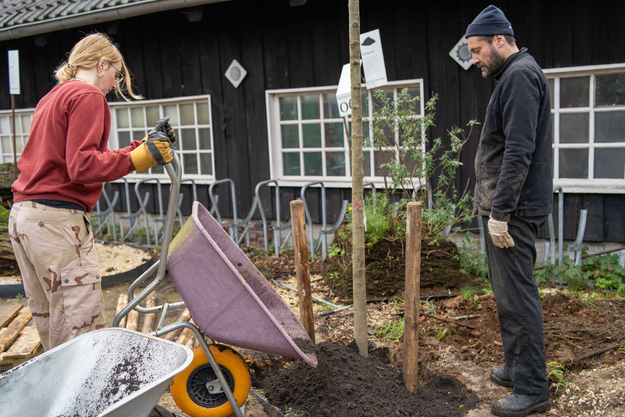
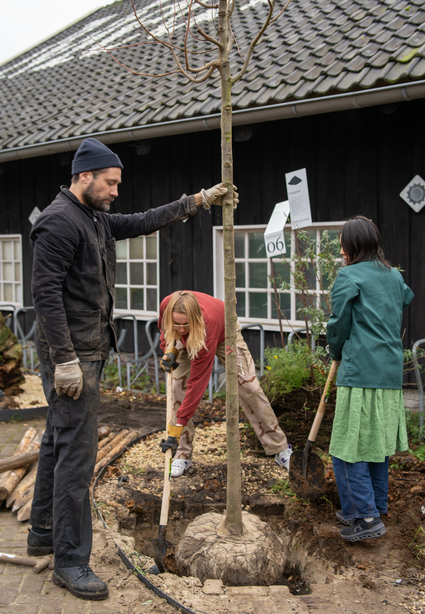
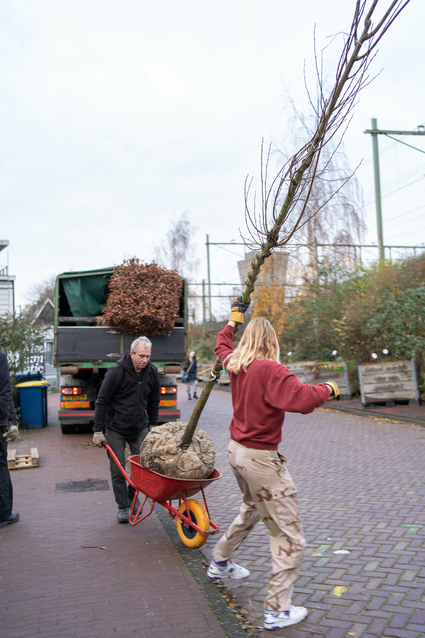
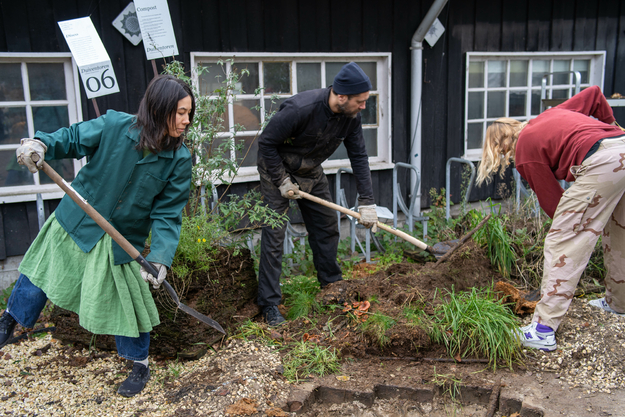
Sources:
Horse Chestnut. (n.d.). NCCIH. https://www.nccih.nih.gov/health/horse-chestnut
Dudek-Makuch, M., & Studzińska-Sroka, E. (2015). Horse chestnut – efficacy and safety in chronic venous insufficiency: an overview. Revista Brasileira de Farmacognosia, 25(5), 533–541. https://doi.org/10.1016/j.bjp.2015.05.009
Linden Information | Mount Sinai - New York. (n.d.). Mount Sinai Health System. Retrieved January 9, 2024, from https://www.mountsinai.org/health-library/herb/linden#:~:text=Tilia%20cordata%2Fplatyphyllos%20flowers%20are
Linde. (n.d.). Parken Met Smaak. Retrieved January 22, 2024, from https://www.parkenmetsmaak.be/linde
Kruiden Geheimen-Linde. (n.d.). Www.kruidenmassages.nl. Retrieved January 22, 2024, from https://www.kruidenmassages.nl/Linde.html
Ulmus Dietary Supplements: Benefits and Safety Information. (n.d.). Www.digicomply.com. Retrieved January 9, 2024, from https://www.digicomply.com/dietary-supplements-database/ulmus
Ulmus minor - Useful Temperate Plants. (n.d.). Temperate.theferns.info. Retrieved January 9, 2024, from https://temperate.theferns.info/plant/Ulmus+minor
